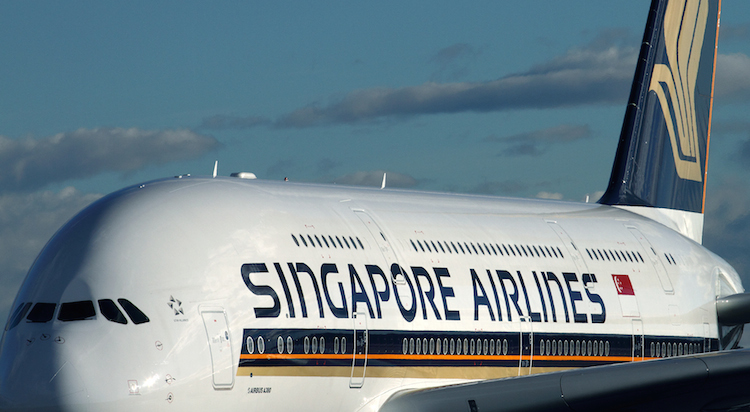
Airbus believes the market for very large aircraft (VLA) such as its double-decker A380 is a growing one as long-haul travel increases and slot constrained airports leave airlines little choice but to upgauge on existing routes to meet demand.
The Toulouse-headquartered manufacturer published its Global Market Forecast (GMF), a look at aircraft deliveries between 2015 and 2034, at the Paris Airshow on June 15 (European time).
It says 32,585 new aircraft deliveries will be needed over the next two decades to meet the growing demand for air travel. The figure is up from the prediction of 31,358 deliveries in its 2014-2033 GMF.
Of those orders, 13,000 will be for replacement, with the remainder to grow the world’s passenger and freighter fleet from about 19,000 currently to 38,500 by 2034.
And Airbus remains confident demand for very large aircraft such as the A380 will continue to grow, predicting 1,550 new deliveries in that segment over the next 20 years, up from 1,501 in the 2014-2033 GMF.
Airbus said 70 per cent of traffic growth until 2034 would come from the airlines’ existing network, increasing the number of aviation “mega-cities” from 47 today to 91 by 2034.
Currently, Melbourne and Sydney fall into the “mega-city” category as both have more than 10,000 daily long-haul passengers. By 2034, the pair was expected to be joined by Brisbane, Perth and Auckland in this part of the world.
“You cannot just increase frequency, you have to have larger and more efficient aircraft,” Airbus chief operating officer for customers said John Leahy said in a statement.
“That’s called the A380.”

Airbus said network efficiencies would also drive the “proliferation of new VLA destinations”.
Ten years after its first flight, the future of the world’s largest airliner – which has not received any new orders so far this year and has seen existing orders either cancelled or deferred – is hotly debated.
Currently, total A380 firm orders stand at 317, with more than half of these already delivered. The A380 program has not received any new orders so far this year and some orders have been either cancelled or deferred.
In contrast to Airbus’s upbeat outlook on the VLA segment, Boeing’s Current Market Outlook (CMO) published on June 11 predicted a shrinking market for aircraft such as the A380 and 747-8.
Boeing expected just 540 new aircraft deliveries of large widebodies over the next 20 years, a reduction of 80 aircraft from the 620 forecast in the Chicago-headquartered manufacturer’s 2014-2033 CMO.
Most of the downward change was tipped to come from Asia, where demand for these very large aircraft was reduced to 140 frames over the next 20 years, 70 aircraft below the 2014-2033 prediction of 210.
Boeing has traditionally regarded the very large aircraft segment as a small market, believing just a handful of airlines around the world had the route structures and capabilities to successfully utilise an aircraft with more than 400 seats.
And Tinseth said many of those routes had now been filled by existing large aircraft. Moreover, airlines were increasingly attracted to new small and medium widebodies given their compelling operating economics.
“We recognise that, we make adjustments to the forecast that are in line with the realities of the market that we see today and developing in the future,” Boeing Commercial Airplanes vice president of marketing Randy Tinseth told reporters during a conference call discussing the CMO.
“It’s been a market segment frankly that we have overestimated demand.”
Where both Boeing and Airbus agree is in the single-aisle segment, comprising aircraft such as the Airbus A320 and Boeing 737, which will dominate deliveries over the next two decades.
Airbus’s GMF said 22,927 new single-aisle deliveries were expected between now and 2034, representing about 70 per cent of all units to be delivered. Moreover, single-aisle aircraft represented 45 per cent of the estimated US$4.9 trillion worth of aircraft heading to airlines over the next 20 years.
In the twin-aisle segment, Airbus increased its forecast to 8,108 new aircraft deliveries, up 322 from its 2014-2033 GMF.
Leahy said the Asia-Pacific was expected to dominate air travel in the coming two decades.
“Asia-Pacific will lead in world traffic by 2034 and China will be the world’s biggest aviation market within 10 years, and clearly Asia and emerging markets are the catalyst for strong air traffic growth,” Leahy said.
“Today, we are ramping up production of the A350 XWB and we are studying further production rate increases beyond rate 50 for single aisle aircraft to meet the increasing demand for air transportation.”
















glen towler
says:I think this is wishful thinking from Airbus. No airline has shown any interest in the A380 apart from Emirates which are pushing a NEO version but the costs of a NEO A380 would be huge so a non starter I think. The future is twin engined not four